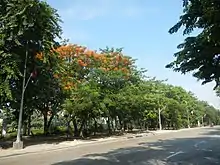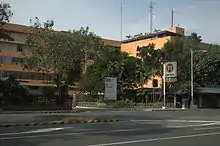Bonifacio Drive
Bonifacio Drive is a road running for approximately 1 kilometer (0.62 mi) in a north-south direction between Intramuros and Port Area in Manila, Philippines.
_sign.svg.png.webp) R-1 | |
|---|---|
 | |
| Former name(s) | Malecon Drive Malecón Paseo de María Cristina |
| Part of | |
| Namesake | Andrés Bonifacio |
| Length | 1 km (1 mi) Approximate length (from Google Maps) |
| Location | Manila |
| North end | Anda Circle in Port Area and Intramuros |
| South end | |
Etymology
The boulevard is named for national hero Andrés Bonifacio, the Supremo of the Katipunan and thus the father of the 1896 Philippine Revolution against the Spanish Empire.
The road was previously called Malecon Drive during the American period.[1] During Spanish rule, it was known simply as Malecón (Spanish for waterfront esplanade) which the road was prior to the reclamation of South Harbor (Port Area) during the late 19th century. It was also known alternatively as Paseo de María Cristina, after the then Queen of Spain Maria Cristina.
Description
Bonifacio Drive is the northern extension of Roxas Boulevard from Padre Burgos Avenue and Katigbak Parkway in Rizal Park to Anda Circle. At the traffic circle, it intersects Andrés Soriano Avenue (formerly Calle Aduana), the main road to Intramuros, and Roberto Oca Street, a road to Port Area. North of the traffic circle, Bonifacio Drive continues as Mel Lopez Boulevard heading into North Harbor and the districts of San Nicolas and Tondo via Roxas Bridge (also known as Mel Lopez Bridge) over the Pasig River.
Establishments

Notable establishments along Bonifacio Drive include the Manila Hotel, the Department of Public Works and Highways headquarters, and the national headquarters of the Philippine Red Cross.
References
- A directory of charitable and social service organizations in the city of Manila published by Archive.org; accessed 2013-12-06.